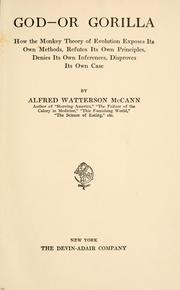
A few months ago, I received a call from someone who wanted to know about Alfred Watterson McCann’s God—or Gorilla, a creationist book from 1922 with, as it happens, my favorite creationist subtitle ever: How the Monkey Theory of Evolution Exposes Its Own Methods, Refutes Its Own Principles, Denies Its Own Inferences, Disproves Its Own Case. The caller also e-mailed a photograph of the title page, so I was able to inform her that hers was a fourth printing of the first edition, while NCSE’s copy is—I added perhaps with a note of pride—a first printing of the first edition. She also wanted to know how much her copy might be worth. Judging from the current prices at on-line bookstores, I estimated that a copy might sell for $12 to $30, depending on its condition, but since the text is out of copyright and freely available on-line, there probably isn’t a huge market.
As long as I was looking at NCSE’s copy, though, I thought that I’d read it through. It begins with what would seem to be a clear irrelevancy: “The world has all but forgotten the ‘Moon Hoax.’ Only very old men and women now remember those wonderful discoveries in the moon by Sir John Herschel in his observations at the Cape of Good Hope.” McCann is referring to a hoax published in The New York Sun in the summer of 1835, ascribing to Herschel a series of increasingly important lunar discoveries, including not only life on the Moon but even intelligent life, in the form of humanoids with leathery wings, which Herschel supposedly dubbed the “Vespertilio-homo, or man-bat.” (Eat your heart out, Bob Kane.) Due probably to the Sun’s editor Richard Adams Locke, the story was arguably the first successful hoax in the history of mass media.
McCann mentions the Moon Hoax in order to pivot to a hoax he deems to be “[o]f far greater significance and of more enduring influence,” namely, “the ape-man hoax now scattering its corruptions throughout the world and impressing its deceptions on the world’s ‘best minds.’” (By “the ape-man hoax” he means evolution in general, although it is indeed human evolution that primarily arouses his ire.) The pivot itself is not exactly convincing, however. McCann writes, “The ‘facts’ [in the Moon Hoax] were first published…in 1835, as Ernst Haeckel and the Darwinians were preparing to trifle with the human mind in a manner unparalleled in history.” Born on February 16, 1834, Haeckel was about eighteen months old when the Moon Hoax was published, so he would not have been preparing to do anything more ambitious than to walk!
That might seem like a petty criticism of McCann. But turnabout is fair play, isn’t it? And McCann certainly wasn’t above petty criticism when it came to the fine details of chronology. In God—or Gorilla, McCann pokes fun at Ernst Haeckel, who “refers to [Lazzaro] Spallanzani in his ‘The Wonders of Life,’ as having done something very extraordinary in the year 1687, which happened to be precisely 42 years before Spallanzani was born.” On the following page, he continues in the same vein, referring to his target’s “flattery of the scientific achievements of a dead priest about whom Haeckel knew so little that he had him breaking out all over with a rash forty-two years before he was born.” There’s no reference to scabies or urticaria or anything of the sort in Haeckel, so that part of the criticism is mysterious, but what about the problem of the date?
McCann is addressing a section of The Wonders of Life that offers a historical treatment of origins-of-life research. Usefully distinguishing between archigony (the origin of life from non-life) and saprobiosis (the supposed origin of life from putrid organic matter), Haeckel is discussing the refutation of the latter idea, starting with Francisco Redi. He mentions Spallanzani’s experimental refutation of the theory of the saprobiotic origin of microbes, which anticipated Pasteur’s, and indeed misdates it to 1687. But the error was clearly a mere typographical error: Spallanzani’s work was in 1768. Obviously the numerals were accidentally jumbled. I checked the original German, Die Lebenswunder (1904), and discovered that the error was Haeckel’s, repeated by his translator Joseph McCabe in The Wonders of Life (1904).
Interestingly, McCann was one of the experts that William Jennings Bryan hoped to recruit for the prosecution of John Thomas Scopes in 1925. (Earlier, in discussing the mysterious figure of Henry F. Lutz, I gave a list of the prospective experts, which also included the flood geologist George McCready Price, Howard A. Kelly of Johns Hopkins University, S. James Bole of Wheaton College, Louis T. More of the University of Cincinnati, Charles B. McMullen of Centre College, and Francis Perry Dunnington of the University of Virginia.) Although he had praised Bryan in passing in God—or Gorilla, McCann responded to Bryan’s invitation (according to Ronald L. Numbers’s The Creationists [1992]) “by chiding Bryan for supporting Prohibition in the past and for now trying ‘to bottle-up the tendencies of men to think for themselves.’”
McCann was born in Pittsburgh on January 9, 1867. A Catholic, he attended Duquesne University, from which he graduated in 1899 and at which he taught English and mathematics until 1912. His real passion was what was called “pure food” and nutrition, though. He wrote on those topics for a number of New York newspapers and in a number of books, including Starving America (1913). “He had a crusading spirit,” according to the obituary in The New York Times for January 20, 1931, “and attacked publically through his newspaper articles both the makers of adulterated or otherwise inferior food and public officials whom he accused of graft in permitting the sale of such food.” As a result, he was often in court, suing or being sued by the objects of such attacks. Late in his life, he began a series of radio broadcasts. He died in New York City on January 19, 1931.

